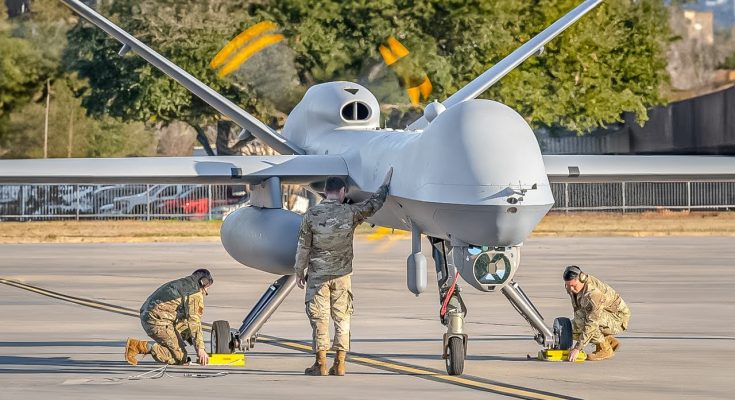The MQ-9 Reaper Drone: The U.S.’s Most Feared Drone Ever Made
The MQ-9 Reaper drone is widely considered one of the most feared and effective unmanned aerial vehicles (UAVs) ever developed, and for good reason. This advanced drone, built by General Atomics, has revolutionized modern warfare by providing unparalleled intelligence, surveillance, reconnaissance (ISR) capabilities, and the ability to carry out precision strikes. The MQ-9’s devastating combination of long-range reach, stealth, and firepower has made it a cornerstone of U.S. military operations and a symbol of modern, remote warfare.
The Rise of the MQ-9 Reaper
The MQ-9 Reaper was developed as an evolution of the earlier MQ-1 Predator, another drone that helped establish the U.S. military’s dominance in unmanned aerial operations. First introduced in 2007, the MQ-9 is more powerful, faster, and capable of carrying a much heavier payload than its predecessor. Designed for extended surveillance and precision targeting, it can be equipped with Hellfire missiles, GBU-12 Paveway bombs, and other advanced munitions. With its ability to loiter over target areas for extended periods and strike with pinpoint accuracy, the Reaper has become a key player in global counterterrorism and counterinsurgency operations.
The Power of Surveillance and Precision Strikes
The primary function of the MQ-9 Reaper is to provide real-time surveillance and intelligence, making it an essential asset for tracking high-value targets. Equipped with powerful cameras, radar, and other sensors, the Reaper can monitor large areas for hours on end, providing detailed intelligence to commanders. This ISR capability allows the U.S. military to track enemy movements and activities, build a detailed picture of battlefields, and make strategic decisions based on near-real-time data.
However, what sets the MQ-9 apart from its peers is its ability to conduct precision strikes. While many drones are primarily used for reconnaissance, the MQ-9 was specifically designed to carry weapons and deliver them accurately. Whether it’s launching Hellfire missiles to eliminate a target on the ground or striking with bombs to destroy fortified structures, the MQ-9 delivers a lethal blow while minimizing collateral damage. The ability to strike from a distance, with the operator located thousands of miles away, adds a terrifying element to the drone’s power.
This capacity for long-range strikes has made the MQ-9 particularly feared in regions like the Middle East, where it has been used extensively to target terrorist organizations such as Al-Qaeda and ISIS. The ability to track, target, and neutralize an enemy from the air without putting a pilot at risk has made the MQ-9 a critical asset in the fight against insurgencies, bringing a new level of precision and control to military operations.
Psychological Impact: Fear Without Warning
One of the most significant aspects of the MQ-9 Reaper’s feared reputation is the psychological impact it has on both adversaries and civilians in conflict zones. Often operating at high altitudes, the MQ-9 is difficult to detect until it’s too late, and its presence in the skies can instill a deep sense of paranoia and fear. Enemy forces know that they are constantly being watched, and the Reaper’s ability to strike without warning only heightens that fear.
For those on the receiving end of the Reaper’s firepower, it’s a terrifying and often invisible threat. The fact that the operator is often located on the other side of the world in places like Nevada only adds to the sense of detachment and inescapability. The drone’s ability to operate remotely, without risking the lives of pilots, has made it a highly effective tool in modern warfare—delivering deadly force with an eerie sense of anonymity.
The Ethical Debate and Controversies
While the MQ-9 has proven to be a valuable tool in modern warfare, its use has not been without controversy. Drone strikes, especially those carried out in populated areas or targeting individuals without trial, have raised ethical questions about the legality of extrajudicial killings and the potential for civilian casualties. The ability to strike from afar has led to accusations of a “robotic” approach to warfare, with critics arguing that drone strikes lack the accountability and oversight present in traditional military operations.
Despite these concerns, the effectiveness of the MQ-9 in asymmetric warfare has made it indispensable for U.S. forces. Its ability to target specific threats while avoiding the risks of traditional combat has made it an attractive tool for counterterrorism and intelligence operations around the world.
Conclusion: A Game-Changer in Modern Warfare
The MQ-9 Reaper drone is a true game-changer in the realm of modern warfare. Its combination of unmatched surveillance, precision strike capabilities, and the ability to operate remotely makes it one of the most formidable weapons in the U.S. military arsenal. Whether feared by enemies or lauded by allies, the MQ-9 Reaper has proven time and again that it is a force to be reckoned with. As technology advances and unmanned aircraft continue to evolve, the legacy of the MQ-9 will undoubtedly remain a defining chapter in the history of warfare.



